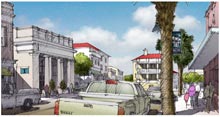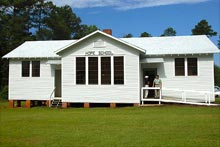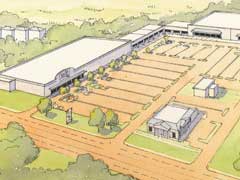A case study in retrofit design by Brown Design Studio
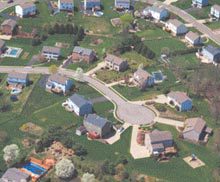 For urban designers, town planners and architects, one of the biggest challenges they face today is the amount of suburban repair work needed. Over fifty years of suburban investment with the most world’s most prolific economic engine means that there is much work to rethink.
For urban designers, town planners and architects, one of the biggest challenges they face today is the amount of suburban repair work needed. Over fifty years of suburban investment with the most world’s most prolific economic engine means that there is much work to rethink.
Post real estate melt-down, many of the boards and commissions in Beaufort County have been focused on this type of repair work. In many cases, it is much like the power went off and simply left half finished developments lying about. The goal of local planners and architects, particularly members of the Congress for the New Urbanism, is to try to repair these areas as best we can and position them up to grow into a type of meaningful place. One strategy to start this effort is to tackle the process of transformation of the ever-common cul-de-sac.
Ironically, the word cul-de-sac means “bottom of the bag” in French. So the bottom of the bag in this case, gets you the residential equivalent of a fast food drive through, easy for cars but bad for humans.
Our case study example here (below) looks much like a typical bottom of the bag, but with a slight “upgrade” of a green space in the middle as a feature. Also, as a more advanced version of the cul-de-sac, it actually has alley ways feeding some of the lots.

That little green circle is nicer than pure concrete or asphalt, but does little on its own. The lot structure is still driving the form of the house placement and you will still end up with something like the next photo, a nicer bottom of the bag.
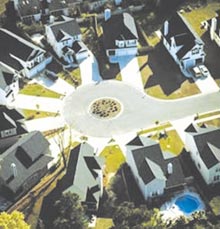
What to do? Well, in many of these types of repair projects, we have many limitations of what we can do. Often, a project is already entitled or zoned and the owner/developer does not wish to go back into that permitting arena. Other times, much of the actual infrastructure is already installed, as is the case here.
One solution is to begin to define the former bottom of the bag into a multi-use place. Cars use this place but so do kids, bicyclists and pedestrians. It becomes a place where social things can happen, as well as a simple, visually pleasing space.
The proposed retrofit, shown below, utilizes three specific techniques:
1. Make a place beautiful. Places that are not visually appealing are not valued as highly as other places. Here we add a squared up center green with a large oak tree planting (and other small details such as lighting etc.)
2. Define the place (space): A place must be defined or enclosed in some manner. Here we focus on moving the building form and mass around to create walls for our new space. The plan has the same number of houses, just moved around to create a better-defined space.
3. Approach of the space: This is the one that many designers overlook. Every interesting space has some type of approach to it. Here we use a row of palmetto trees to create a tighter street section and rhythm that then opens up to the main space.
These are simple fixes that costs very little in terms of actual dollars spent. We also kept existing utility runs and really only changed some lot lines, house placement and a few ornamental design moves inside the right of way.
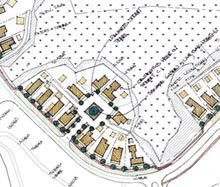
As an alternate, we also looked at another version here (below). This is a more involved approach as we moved the right of way slightly, and actually carved out a small block structure in the former cul-de-sac parcel. Our main goal here was to generate more value by fronting our homes on a more controlled common green versus a less desirable suburban second tier arterial road.
We used the same basic principals as above but just modified the plan so that 8 of the 12 homes faced the value generating space vs. 4 in the other example. Since this is a real world project, our client and design team will now have to weigh out the extra value generated in sales of our approach vs. the extra design and engineering needed to convert to this scheme. Our earlier example, needed almost no additional engineering or approvals.
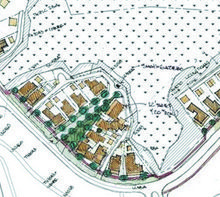
There is hope to punch out of the bottom of the bag. Breaking the cul-de-sac is easy to do from the point of view of a designer of real world solutions to this large problem. Here, remember that our three main principals; Beautiful Places, Defined Places and Anticipation of a Place were used to build extra value out of typical a feature found in suburban areas.
This article was written for Lowcountry Weekly by the Congress for the New Urbanism – Carolinas Chapter. For more information, visit www.cnu.org

